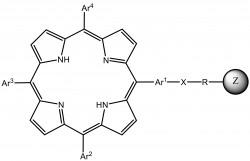Abstract
The present invention is concerned with the preparation method, fast and at room temperature, of a very porous new ceramic material, that combines fast setting of magnesium phosphate cements with the gas evolution that occurs during carbonates dissociation in acidic media.
The mixture of dry powders can be commercialized already prepared and water added at building site. The wet mixture can be cast in moulds, projected onto surfaces and injected into cavities, hardening in a few minutes. The final product has macro, micro and nano interconnecting pores, which confer thermal insulation, sound absorption, permeability and low density characteristics, having nevertheless mechanical strength rarely found in products with comparable porosity. It is bio and eco-compatible and allows particles and fibers incorporation for property reinforcement or gradation, finding environmentally sustainable applications as a biomaterial, filter media, in building industry, architecture, landscaping and agriculture.
Innovative aspects & main advantages
The preparation method of these porous ceramic artefacts explores the synergies of the innovative combination of the fast setting of magnesium phosphate cements with the gas evolution that occurs during carbonate dissociation in acidic media. The method is entirely carried out at room temperature and stems from the very well establish casting technique used with Portland cement based artefacts. However, in comparison with the latter, it is much faster and enables the expeditious production of very porous ceramic objects with mechanical strength values rarely found in other ceramic materials with comparable levels of porosity. While wet, the casting mixture has excellent capability to reproduce every mould detail; the setting time can be conveniently adjusted to the particular application, with minimal dimensional change during setting; after setting, the hardened mixture shows no adhesion to polymers (ideal mould material) and strong adhesion to other inorganic materials (including metals).
Applications
Given that fast setting occurs simultaneously to the carbonate dissociation, a peculiar microstructure of communicating macro, micro and nano pores is established, which can be tailored to any application requiring heat or sound insulation (as in civil construction and architecture) and permeability to gases or liquids (as in filters or permeable pavings and tiles in agriculture or landscaping), while combining low density with high mechanical strength. Being magnesium phosphate based, these materials are also environment-friendly (magnesium is the central ion in the chlorophyll molecule) and bio-compatible (can be used with or instead of hydroxyl-apatite).
Inventors
Segadães, Ana; Morelli, Márcio; Zurba, NadiaOur Inventors
Applicant
Fundação Unversidade Federal de São CarlosUniversidade de Aveiro












